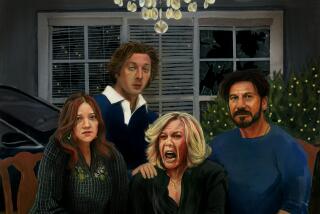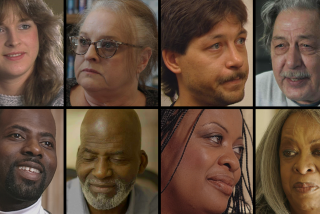Inside the Emotional Foundry : The families we were are the families we become : INTIMATE WORLDS: Life Inside the Family, <i> By Maggie Scarf (Random House: $25; 464 pp.)</i>
- Share via
These days we’re led to believe that the American family is under siege, as susceptible as an endangered ecosystem to the bulldozer of society, and that if it only mandated some protection, it would naturally work its own way back to a rosy state of health. Maggie Scarf’s ambitious book explores the inner workings of contemporary families to argue that, on the contrary, a family disregards external influences--it’s a closed system whose behavior is determined almost exclusively by its own members.
Scarf, author of previous books on marital relations and on women and depression, conducted extensive interviews with more than 50 families, diverse in form, ethnicity and economic status. “I began to view the family as a great emotional foundry,” she writes, “in which our deepest realities--our sense of who we are as persons, and of the world around us--first begins to form and take shape.” The patterns of behavior her subjects learned in their families of origin were often replicated with eerie exactitude in the families they created as adults. Further, these behaviors fell into specific, recognizable stances. Using the Beavers System Model, an assessment device used for research and therapeutic purposes, she ranks the health and competence of four families.
The Level 5, severely disturbed family, is characterized by chaos and incoherence. The parents blame their adolescent son for his increasingly violent and threatening behavior, finally taking him against his will to a psychiatric hospital, but they do not acknowledge how their own secrets and confused rage might affect their child. In this anarchic system, members of the family struggle for clarity and yet are simultaneously terrified of achieving it because the truth is felt to be too painful to endure. No one is capable of listening or engaging, and causal relationships between emotion and event are denied. The delinquent son is simply the “symptom bearer” of a seriously misaligned family.
The symptom bearer in the family next introduced by Scarf is a bulimic daughter. The Level 4, or borderline, family has resolved the problem of incoherence in a primitive manner, by installing a tyrannical leader. Power is now polarized; the father strictly regulates the behavior of all family members, including what will be eaten for breakfast, and threatens abandonment if his edicts are opposed. In a household where everything is black and white, any ambivalence or any attempt by a child to individuate is decried as treason. The daughter’s eating disorder, although self-destructive, represents the only choice available to her for attaining individual control.
As a family moves higher on the Beavers scale it becomes more adept at handling the core issues of power, conflict and intimacy. Most families fall into the mid-range, Level 3 category, which has deposed the tyrant in favor of an internalized system of rules, silently agreed upon by each member. To the outside observer, these families appear to function relatively well, but they are in the grip of a painful dilemma, either to follow the prescribed set of behaviors or to feel guilt for breaking the rules. Constantly monitoring themselves, they lose sense of what they actually feel. The sacrifice is great: Real intimacy cannot flourish without self-knowledge or expression of true feeling. The atmosphere in these families is one of pervasive loneliness. They coexist but do not connect.
The last family, representing both levels 1 and 2 on the Beavers scale, is flexible and resilient in the face of conflict. Ambivalence is acceptable, power is shared and difference among its members is not only tolerated but is a source of delight. Throughout her interviews and analysis, Scarf proves to be a compassionate, clear-eyed investigator, as she teases apart the gnarls of family histories and motives. To add force to her assertion that our families of origin provide the blueprint for how we relate to others in later life, she covers a lot of ground--with in-depth discussions of bulimia, alcoholism and much psychological theory--and if the book begins to feel somewhat encyclopedic it is because she cannot repeat often enough that how we treat others in our families is vitally important. “Doing things differently, therefore--changing the family drama in significant ways--is an act of creativity, of first imagining and then implementing the construction of an alternate kind of reality.”
This book is wrought with care and commitment, it is meticulously researched and will, I think, serve as a valuable resource for families struggling to understand themselves. Yet in the end, my response to “Intimate Worlds” was lukewarm.
A family is a complex, often ragged universe. Scarf has exerted tremendous energy and skill to clean up the loose ends. The model is useful as an analytical tool, but it begins to feel constraining; its measurements, rudimentary. She states that the single-parent and inner-city families she interviewed also fall into the same five behavioral patterns, but surely she ran across exceptions that might have raised provocative questions about the inheritance of familial behavior or about the very nature of family itself. (A fascinating section discusses extended families in African American communities.) The decision not to explore these exceptions closes off further investigation.
A test is included at the end of the book, so that readers can locate themselves on the Beavers System scale. I took it, of course--who wouldn’t? I charted my family of origin’s slow slide from Level 3 through Level 4, to the very brink of a Level 5 diagnosis. It may be strangely comforting to believe that a number could explain an entire constellation of tendencies and behaviors--it’s a neat package--but a number is a dead end, it does not teach us how to live in a qualitatively better way. At her best, Maggie Scarf urges us to teach ourselves.
More to Read
Sign up for our Book Club newsletter
Get the latest news, events and more from the Los Angeles Times Book Club, and help us get L.A. reading and talking.
You may occasionally receive promotional content from the Los Angeles Times.







